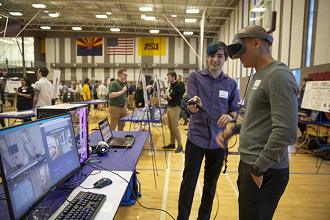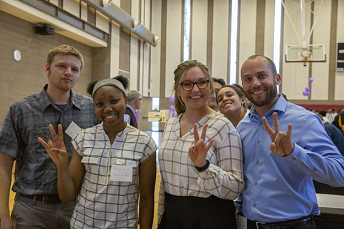Capstone Projects Team Undergraduates with Company Sponsors
With the increasing need for new talent, especially in engineering, companies are seeking ways to connect with students before they graduate to build relationships that aid in the recruitment process for new engineers and other professionals.
WHAT IS A CAPSTONE PROJECT?
Many universities require final projects from their students, usually in the senior year of their undergraduate program. Often called capstone projects, these are intended to help students integrate what they have learned in their classes and experience working on a real-world project. Since problems in the working world are often complex, open-ended and require teamwork to solve, students who complete capstone projects gain a valuable introduction to their work life after graduation.
In engineering programs, capstone projects usually involve tackling a problem or design challenge posed by a company or nonprofit organization. Typically done by teams of students, these projects generally take place over two semesters, structured through capstone classes. At the end, the teams prepare reports and present their designs or solutions to the sponsoring company and to their academic department (Figures 1 and 3).
Sometimes the final presentations are open to the public. Some community colleges offer capstone projects, as well, and so do some graduate programs.
WHAT KIND OF PROJECTS?
Students at The Ohio State University (OSU) have done several valve-related capstone projects for a company that produces a lot of valves for offshore applications, said Bob Rhoads, director of the engineering capstone program there. The projects included evaluating seawater corrosion of different materials and testing elastomers.
At the Polytechnic School at Arizona State University (ASU), a student team designed and built an automated flowline test stand to validate aircraft pneumatic valves after repair and overhaul procedures, said Tim Beatty, associate director of eProjects/capstone projects. Another team developed a fluid-powered bicycle. This included design, simulation, construction, testing and qualification of a bike for competition in the National Fluid Power Association Fluid Power Vehicle Challenge.
At Rochester (NY) Institute of Technology, a craft brewery sponsored a project to develop “a simple solution to automated keg washing made using readily available components.” The student team studied existing commercial keg washers and came up with a simplified approach that met the sponsor’s requirements (Figure 2).
For an additional sampling of projects, see: Examples of Capstone and Similar Company-Sponsored Projects. At some schools, the projects are interdisciplinary and may include students from sciences, management, marketing and other areas of study.
BENEFITS TO SPONSOR COMPANIES
Companies can benefit in many ways from sponsoring capstone projects, such as the following, gathered from Arizona State University and The Ohio State University
- Interact directly with students
- Tap students’ creativity and problem-solving skills
- Improve processes, products and productivity
- Gain fresh perspective from innovative engineering students
- Improve quality and reduce costs
- Evaluate student talent in a project setting
“Sponsors really like working with students,” Rhoads said. “I have repeat sponsors—the same company and the same individuals to work with the students. They want to be part of developing the next generation of engineers.” The students grow from the beginning of the autumn semester to the end of the spring semester, not just as young engineers, but as people, he said.
Sponsors of capstone projects at The Polytechnic School (TPS) at ASU are impressed with the students and how out-of-the-box creative and innovative they are, Beatty said. In addition to the creative freedom, the program involves a lot of writing, communicating and program management—skills not generally covered in class work that will be useful to students in their careers. “We try to simulate the real world as much as we can,” Beatty said.
The students benefit, too, of course. About 15% of TPS capstone sponsor companies are located far from the campus. This is different from many capstone programs, which require sponsors to be fairly nearby, and is actually a good thing, Beatty said. It prepares students for careers where they will quite likely be working with colleagues in different countries on different continents in different time zones.
This is an educational experience for the students, learning to function as a team and applying their academic knowledge while working hands-on. It’s also an opportunity to learn about specific companies and industries, perhaps prospective employers, by direct contact with products, processes and working engineers and other professionals.
HOW TO SPONSOR A CAPSTONE PROJECT
The National Fluid Power Association (NFPA) offers a summary of how to sponsor a capstone design project. One suggestion for finding a program is to look for higher education institutions accredited by ABET, which requires a capstone-type project in engineering programs.
These programs are structured to benefit both sponsors and students. Policies are in place about what support the sponsor provides, what part the university plays and what happens to any intellectual property created.
Programs differ, but generally the sponsoring company provides not only the problem to be solved or the design challenge, but also helps fund the work and provides support by one or more employees who join faculty members in mentoring the student teams. The work is usually done on campus, but may involve visiting the sponsor company or other locations.
The sponsor company typically receives the prototype built, drawings made, code written, etc., and owns any intellectual property created.
OTHER WAYS TO ENGAGE WITH STUDENTS
In the Microenterprise program at Ranken Technical College in St. Louis, students participate in paid part-time work on campus performing tasks for sponsoring companies. Nidec Corporation, manufacturer of many kinds of motors, participates in this program and refers to it as a reverse internship, where the work comes to the student, rather than the student going to the company to work.
A quick-turnaround project approach is Rochester (NY) Institute of Technology’s IdeaLab. Companies pose design problems that will benefit from brainstorming a creative approach. Teams of students do a weekend blitz of brainstorming, design, prototyping and testing with help from faculty and professionals from the sponsoring company. If the results interest the sponsor, the team can proceed to an IdeaMake semester to do further development.
Many opportunities exist for connecting with students at universities and other institutions of higher learning—as well as the benefits to sponsoring companies.
Barbara Donohue is web editor at VALVE Magazine
Examples of Capstone and Similar Company-Sponsored Projects
Oregon State University A team developed process improvements to speed the product changeover time on a freeze-dry packaging line for a food processing plant.
University of Minnesota A student team partnering with Tennant Corporation, manufacturer of commercial floor cleaning equipment, developed a piston pump centering mechanism for an industrial sweeper.
University of San Diego A team of mechanical and electrical engineering students designed and built an automated cryogenic flow control system for an unnamed industry sponsor.
University of South Carolina A South Carolina children’s museum has a huge sculpture of a child, the cleaning of which was very difficult. A capstone project team developed a robotic drone to blow dust off the sculpture.
RELATED CONTENT
-
The Evolution of the All-Encompassing Ball Valve
The compact design, simplicity of use, ease of repair and wide performance capability have helped to make the ball valve a dominant design in modern industrial applications.
-
Check Valve Installation Considerations to Maximize Process Performance
Key considerations in successful check valve performance.
-
Regulators versus Control Valves: What’s the Best Fit?
The combination of North American shale fields that continue to fuel high levels of new domestic oil and gas projects and ongoing global efforts means the need for efficiency in instrumentation selection has never been higher.













 Unloading large gate valve.jpg;maxWidth=214)